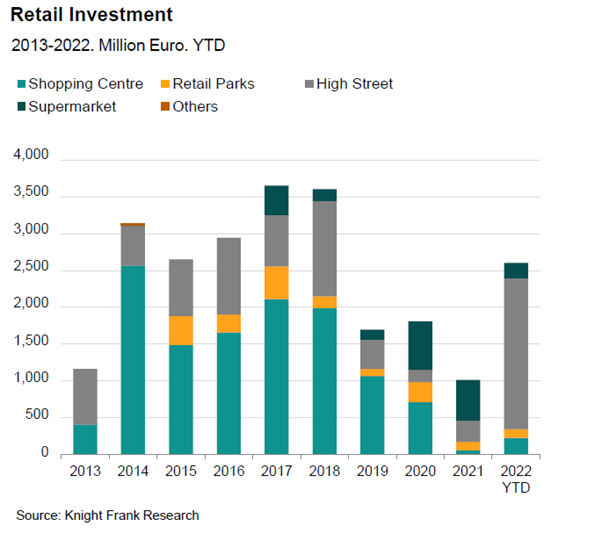Hybrid Spanish retail market rallies investors
The e-commerce boom born out of the pandemic and a return to usual shopping habits has created a road to recovery for retail market.
5 minutes to read
Spain has experienced its biggest e-commerce boom during the pandemic years, and it is now, with the return to normality, that the new hybrid shopping model is really consolidating.
Increase in footfall and sales in shopping centres (+30% and +33% respectively in Q1 2022 vs. Q1 2021) and the continued growth of e-commerce (+6% in Q1 2022 vs. Q1 2021) support this trend.
In short, the retail sector is recovering thanks to the consumer's desire to return to normality, to experience physical shopping, to the strong return of tourism and to the adaptation of commercial spaces to new shopping models, among other factors. The boost in consumption and potential upside is motivating investors to regain confidence in the sector, who are once again showing great interest.
According to the International Monetary Fund (IMF), it is the country with the best projection among the advanced economies, the Spanish GDP closed the year 2021 with a growth of 5.1% compared to 5.2% in the Eurozone. The growth forecast for 2022 is 4.8% and for 2023 is 3.3%, while in the Eurozone growth is expected to be 2.8% for 2022 and 2.3% for 2023.
One of the hardest hit sectors, retail, transport and hospitality, is recovering strongly with a year on year growth rate of 42.5%.
The remarkable return of tourism, especially international tourism, has undoubtedly been one of the main drivers of this recovery with 6.1 million international tourists in April this year, a figure well above that recorded in April 2021, up 870%, and already close to pre pandemic figures (7.1M in the same period of 2019). The average spend per international tourist in April was €155 per day, even exceeding the average for the same period in 2019 (€154 per day) and almost 20% more than in April last year.
On the other hand, the consumer confidence index is also gradually recovering from the sharp drop in March due to the Russia Ukraine war, inflation and the energy crisis. In April it stood at 74.6 points, which is 20.8 points higher than the previous month.
Shopping centre sales
This increase in consumer confidence and the reactivation of international tourism, together with the return to normality, have been key to the growth in sales in textile fashion shops so far this year in Spain. May saw an exceptional increase in fashion sales of more than 16%, and a cumulative increase of almost 20% so far this year.
As for sales in shopping Centres in Spain, in the first quarter of 2022, they have increased by almost 33% compared to the same period of the previous year according to the Spanish Association of Shopping Centres and Commercial Parks (AECC). Footfall has also experienced a growth of around 30% compared to the first quarter of 2021, although still without reaching pre pandemic sales or affluence figures (AECC data).
E-commerce
The pandemic has undoubtedly had an unprecedented impact on the progress of e-commerce in Spain, with consumers having to radically change their shopping habits by moving from the physical shop to the digital world.
According to the SalesForce Spain platform, digital commerce in the first quarter of 2021, experienced exponential growth of up to 70% compared to the beginning of 2020, just before the pandemic. Thereafter, there is still an increase, but less significant, reaching 6% at the beginning of 2022.

These data reflect the continuing importance of the digital channel, although without the negative impact on the physical shop that was expected due to the scenario that was experienced during the months most affected by the pandemic, where the physical shop was crushed under e-commerce.
Retail investment rising
The retail sector has generally been one of the hardest hit since the start of the pandemic. However, 2022 is seeing a clear recovery, with more than €2.6 billion invested to date, which is almost 160% more than all the investment made in 2021 and even more than in 2020 and 2019, the year before the pandemic.
By sub sectors, it is the High Street that stands out the most, accounting for almost 80% of total investment so far this year and exceeding by 600% all the investment registered in high street in 2021. Of note was BBVA's purchase of the Tree Portfolio, comprising almost 700 branches from Merlin Properties for almost €2.0 billion.

Booming Sectors
The good progress that began during the pandemic continues in certain sectors such as the food sector. This is the case of companies such as Mercadona, which, despite the increase in the price of raw materials and transport that occurred a few months ago, has had a 3.3% increase in turnover. In fact, the Spanish company is in 38th position in the "Brand Finance Retail 2022" ranking, which lists the 100 most powerful brands worldwide, taking into account their economic returns, marketing and public perception.
The restaurant industry is also experiencing a good moment, now that consumers have greater freedom to enjoy leisure and socialising , and spaces are opening up where they can enjoy good gastronomy in a pleasant environment, often in the open air. Even some restaurants with shows that combine gastronomy with
entertainment are beginning to be implemented with force.
On the other hand, fashion is also strong and giants such as Inditex continue to expand. The company has opened the world's largest Zara in the Spanish capital, which it shares with Stradivarius. It is located in the España building and has 9,000 m² and four floors. Uniqlo, the Japanese retailer, has also announced that it will open its largest shop in the centre of Madrid in 2022, possibly after the summer.